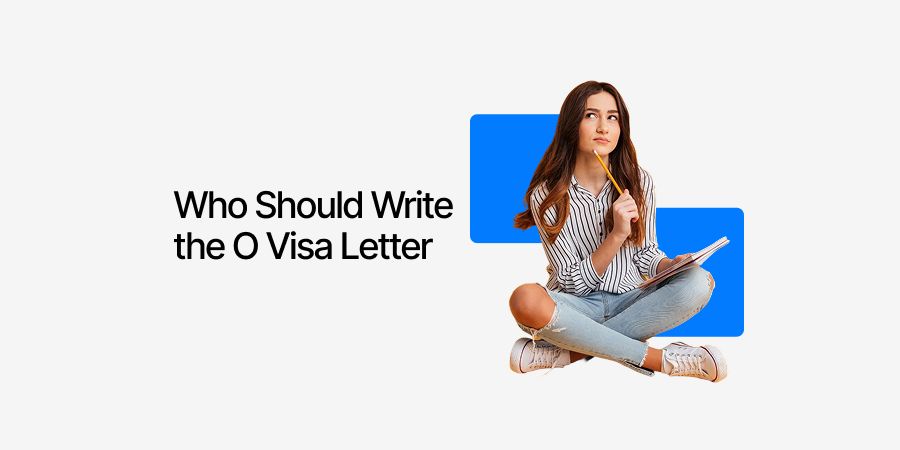
How to Write a Reference Letter for an O Visa
An O Visa is often described as the visa for extraordinary ability. It allows professionals in arts, sciences, business, education, and athletics to live and work in the United States if they can prove their achievements are exceptional.
Winning awards, gaining press coverage, or leading major projects all help, but immigration officers rarely rely on documents alone. They want to see how peers, mentors, and industry leaders view the applicant’s work. That is where reference letters come in.
A reference letter is not just a formality. It adds depth to the application and helps USCIS understand why the applicant deserves approval. Done well, it becomes one of the most persuasive parts of the petition.
Done poorly, it risks turning strong achievements into vague or generic claims. This article explains how to write a reference letter that works for an O Visa.
O Visa and the Role of Reference Letters
The O Visa applies to individuals who can show national or international recognition. USCIS expects proof that the applicant is at the top of their field, not simply competent. Evidence often includes awards, publications, memberships, or major contributions.
These items, however, need interpretation. A press article might highlight a win, but it does not explain why the win matters. A publication may look impressive, but the impact is lost without context.
This is why reference letters hold so much value. They connect the dots for the adjudicator. A recommender can explain why a particular award is competitive, why a project influenced an industry, or why a performance was groundbreaking. In other words, the letter provides expert interpretation of the applicant’s achievements.
Reference letters also act as credibility markers. When a respected figure in the field takes time to endorse an applicant, it signals authority and trust. USCIS reviewers, who may not have specialized knowledge in every domain, often lean on these endorsements to judge whether the applicant truly qualifies as extraordinary.
A strong letter transforms evidence into a narrative of excellence. It highlights not only what the applicant did, but also why it matters. This dual role—context and credibility—is what makes reference letters essential for an O Visa petition.
Who Should Write the O Visa Reference Letter
The value of an O Visa reference letter depends heavily on who writes it. A letter from someone with authority and recognition in the applicant’s field carries far more weight than one from a casual colleague or friend. USCIS expects referees to be credible and established. Their reputation directly impacts how persuasive the letter will be.
Ideal referees include respected industry leaders, senior executives, professors, or award committee members. These individuals not only understand the applicant’s work but also have a professional standing that signals credibility. For example, a CEO of a recognized company or a well-published researcher is a strong choice.
Applicants should avoid selecting referees who lack influence. A letter from someone without recognized credentials may weaken the petition, even if that person knows the applicant well. The quality of the recommender matters as much as the quality of the writing. Choosing the right referees ensures the letters present the applicant as extraordinary in the eyes of decision makers.
Key Elements of the O Visa Reference Letter
A reference letter for an O Visa is effective only when it includes specific, verifiable details. A generic endorsement will not meet USCIS standards. Strong letters consistently include the following elements:
Recommender identification
The letter should open by clearly identifying who the recommender is. This includes their name, title, current position, and relevant background.
Professional authority
The recommender should provide context for their authority. Mentioning achievements, publications, awards, or leadership positions shows USCIS why their opinion carries weight.
Relationship with the applicant
The letter must explain how the recommender knows the applicant. This can include professional collaborations, evaluation of work, or industry interactions.
Specific achievements
The strongest letters describe concrete accomplishments. These may include high-impact publications, prestigious awards, media recognition, or leadership in important projects. Whenever possible, measurable details such as audience size, citation counts, or global reach should be included.
Explanation of impact
Achievements alone are not enough. The recommender must explain why those achievements matter to the field. This context proves extraordinary ability rather than routine success.
Closing endorsement
The letter should end with a clear and confident endorsement of the applicant. It should explicitly state that the applicant is extraordinary and deserves the O Visa.
Structure and Writing Best Practices for O Visa Letters
A reference letter for an O Visa should follow a clear and professional format. A well-structured letter ensures that USCIS officers can quickly understand the credibility of the recommender and the significance of the applicant’s achievements.
A typical letter has three main sections: introduction, body, and conclusion.
The introduction should identify the recommender, outline their professional authority, and describe their relationship with the applicant. This sets the stage for why their perspective matters.
The body of the letter should focus on the applicant’s accomplishments. Each paragraph should highlight one achievement or contribution, followed by context that explains why it is exceptional.
Specifics are crucial. Instead of writing “she is an excellent researcher,” a stronger line would be “her research on renewable energy has been cited over 200 times in international journals and directly influenced government energy policy.” Numbers, awards, and measurable recognition strengthen the case.
The conclusion should summarize the recommender’s support and provide a confident endorsement. Phrases like “I strongly recommend the approval of this O Visa petition” give clarity and leave no doubt about the recommender’s opinion.
Tone and language must remain formal and precise. Overly casual wording undermines credibility.
At the same time, heavy jargon should be avoided, as immigration officers may not be experts in the applicant’s technical field. Letters should be written in a way that is both professional and accessible.
Common Mistakes to Avoid in O Visa Letters
Even highly qualified applicants see petitions delayed or denied because of weak letters. The most common mistake is vague praise without supporting evidence. Statements such as “he is the best in his industry” or “she is highly talented” have little impact unless paired with concrete details.
Another mistake is choosing the wrong recommender. A respected title is necessary, but the person must also have knowledge of the applicant’s work. A well-known figure who barely knows the applicant may produce a weak, generic letter that lacks authenticity.
Applicants should also avoid using online templates or recycled text. USCIS officers can recognize letters that appear formulaic or copied. Each letter must feel original and tied to the applicant’s specific achievements.
Finally, exaggerations or unverifiable claims damage credibility. Every statement in the letter should be truthful and supported by evidence when possible. Consistency across all supporting documents strengthens the overall petition.
Sample Outline of the O Visa Reference Letter
A good O Visa reference letter is not complicated, but it must be structured correctly. The following outline shows the flow most letters should follow:
-
Header and date: Include recommender’s full details such as name, title, organization, and contact information.
-
Introduction: Present the recommender’s professional background and explain their relationship with the applicant.
-
Body paragraphs: Highlight the applicant’s main achievements. Each paragraph should focus on one contribution and include context, measurable details, or recognition that proves extraordinary ability.
-
Conclusion: Provide a strong, clear endorsement that states the applicant is an outstanding candidate and should be granted the O Visa.
-
Signature: End with the recommender’s signature and official designation.
This outline creates consistency across letters while leaving room for personal details that make each endorsement unique. Tools like ChatGPT and Chatly can make this process easier, enabling you to make the most of AI.
Conclusion
The O Visa is awarded only to individuals who can prove they are exceptional in their field. Reference letters are a key part of that proof.
They transform a stack of documents into a persuasive story of achievement by explaining why each success matters and showing that respected figures in the industry stand behind the applicant.
A strong letter combines credibility, structure, and detail. The right recommender should be authoritative, the content should highlight specific achievements, and the tone should remain professional throughout.
Avoiding vague praise, generic templates, and unsupported claims is just as important as including measurable accomplishments.
For applicants, selecting the best referees is a critical first step. For recommenders, taking the time to craft a letter that is both detailed and authentic can make the difference between success and rejection.
When written correctly, these letters not only meet USCIS requirements but also elevate the entire petition.
Suggested Reads
Frequently Asked Questions
Most frequent questions related to writing an O Visa reference letter.
More topics you may like

How to Write a Brand Collaboration Proposal in 2025

Muhammad Bin Habib

How to Write a Case Report in 2025

Muhammad Bin Habib

How to Write a Complaint Letter to a Hospital


How to Write a Cover Letter with No Experience Using AI Chat

Muhammad Bin Habib

How to Write a Case Study, with Examples, Tools and Templates

Muhammad Bin Habib
